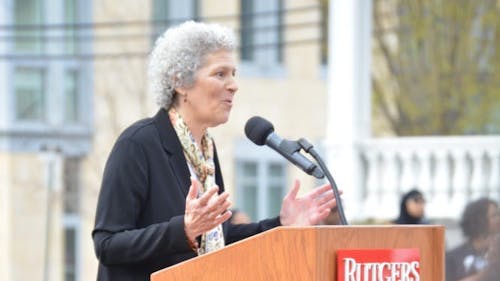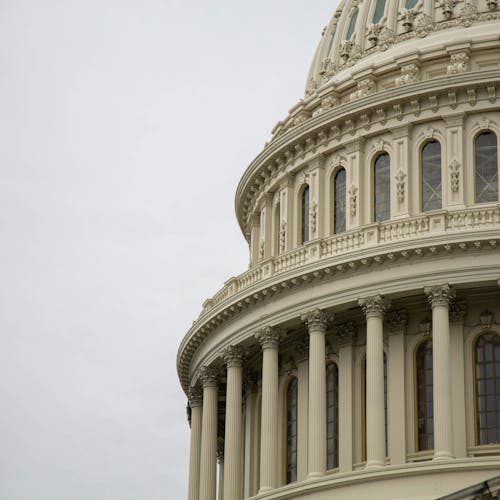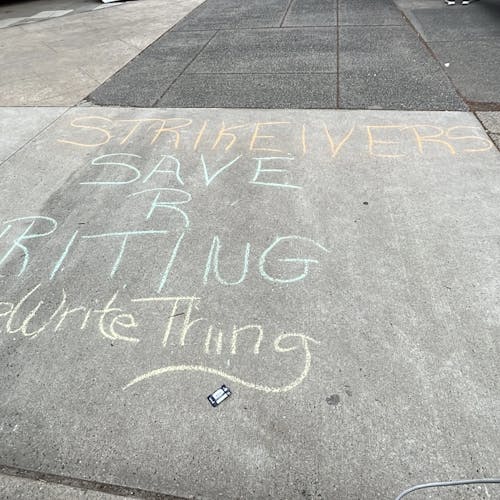Rutgers Class of 1971 unveils new plaza in commemoration of Paul Robeson

Last Friday, under sunny skies, hundreds of students and Rutgers alumni gathered at Voorhees Mall to celebrate Paul Robeson’s legacy and watch the unveiling of the Paul Robeson Plaza in his honor.
Before the official ribbon-cutting for the plaza, people were able to enjoy free food, games, inflatables and prizes from 1 to 3 p.m. Promptly afterward, participants gathered in front of a podium adjacent to Voorhees Hall, where Felicia McGinty, executive vice chancellor for Administration and Planning, gave the opening remarks.
“I can hardly contain my excitement,” she said. “Today, Paul Robeson returns to the Banks.”
The next speaker on the stage was Reverend Gregory Smith Robeson, a foundation chief executive pastor and nephew of Paul Robeson. He first reminded the audience of Paul Robeson’s achievements as a scholar, an athlete and a linguist, highlighting Paul Robeson’s role in the fight for civil rights especially.
“He used his prestige and talents as weapons for the struggle for freedom,” Gregory Smith Robeson said.
University President Robert L. Barchi also spoke at the event, acknowledging that while Paul Robeson was one of the most notable alumni to have graduated from Rutgers, what he fought for also brought to light the University’s dark history.
Barchi said that Rutgers was currently at a “moment of reckoning” as an institution, because for the past few years, it has been working to confront its history of involvement in race and equality.
“We haven’t been shying from those facts,” he said during his speech. “We’ve been publicizing them, we’ve been discussing them and we’ve been memorializing them. We’ve not been taking names off of things, we have been pointing out why they’re there.”
Paul Robeson himself had challenges while studying at Rutgers. For example, the University made him sit on the bench during a football game because the opposing team refused to play with a Black man on the field, Barchi said.
The location of the plaza was also reflective of his legacy. Not only was the plaza located centrally between College Avenue and the vista between Seminary Place and Bishop Place, but it was also meant to be a space of introspection and contemplation.
Jim Savage, a Rutgers alumnus and chair of the Class of 1971 45th Milestone Campaign Committee to build the Plaza, said it was in New Brunswick as opposed to Piscataway because that was where Paul Robeson took classes when he studied at Rutgers.
Savage said the plaza also included photographs of Paul Robeson on black granite to provide a story of his life’s work, and a ground space in between the walls meant for people to inscribe words of their choice.
Claude White, who served as president of the Class of 1971 while at Rutgers, took the time to also thank those who were involved in the plaza’s creation and participants in joining to celebrate Paul Robeson’s legacy.
“It is with a great sense of gratitude that on behalf of the Class of 1971, we are thankful for your presence here today, your support and your participation in this event,” he said at the podium.
White gave appreciation especially to Savage, whose steadfastness and planning was one of the main reasons why the plaza was able to be created. In an email to The Daily Targum, Savage said his responsibilities included publicizing the project, gaining approval from the administration and serving as the chief spokesperson for the campaign.
More than five years of work went into the project, with Savage describing how he had to coordinate meetings with the Class of 1971 Committee, chair of Africana Studies Edward Ramsamy and Rutgers African-American Alumni Alliance (RAAA), among other committees.
Considerable research was also required, since there had to be visits to museums and archives to find images for the plaza.
Savage said that the goal was to have the tribute completed during the centennial of Paul Robeson’s graduation, rather than as a 50th reunion gift. The project was especially meaningful because he believed Paul Robeson had not been given the justice and honor that he deserved, and instead was ignored in American history.
“Based on our research, this monument is the most significant public tribute to Paul Robeson in the world. It will serve to education many people regarding Robeson’s life journey, including the obstacles he faced and the challenges he overcame,” Savage said.
Mayor James Cahill then described in his speech how Paul Robeson’s legacy extended outside of Rutgers and into the city of New Brunswick. He said there were currently 700 students at the newly expanded Paul Robeson Community School for the Arts, which was located near the newly renamed Paul Robeson Boulevard.
The next speaker was Susan Robeson, the granddaughter of Paul Robeson, who first took a moment to acknowledge the fact that the audience was standing on traditional Lenape grounds, which was especially important because Paul Robeson’s mother was of Lenape descent. She also mentioned the efforts of her father, Paul Robeson Jr., who also made efforts to commemorate Paul Robeson.
“This is a fruit of his labors, which often went unnoticed and scorned, without receptivity. So do I wish he was here,” Susan Robeson said. “I’m sure in spirit, he is.”
Last to speak was Channel Jordan, a School of Arts and Sciences senior. As a member of the secret society Cap and Skull — which Paul Robeson had also been a part of — she said that Cap and Skull had been involved in the Knight’s Call, which were the five values that every Rutgers student learned during orientation: authenticity, inclusivity, responsibility, engagement and resilience.
“As I leave Rutgers and my own legacy behind, I hope that we remember the history and legacy that Robeson left behind. I challenge the University and Scarlet Knights to move forward in our calendars while also remembering the history that has brought us here,” Jordan said.



